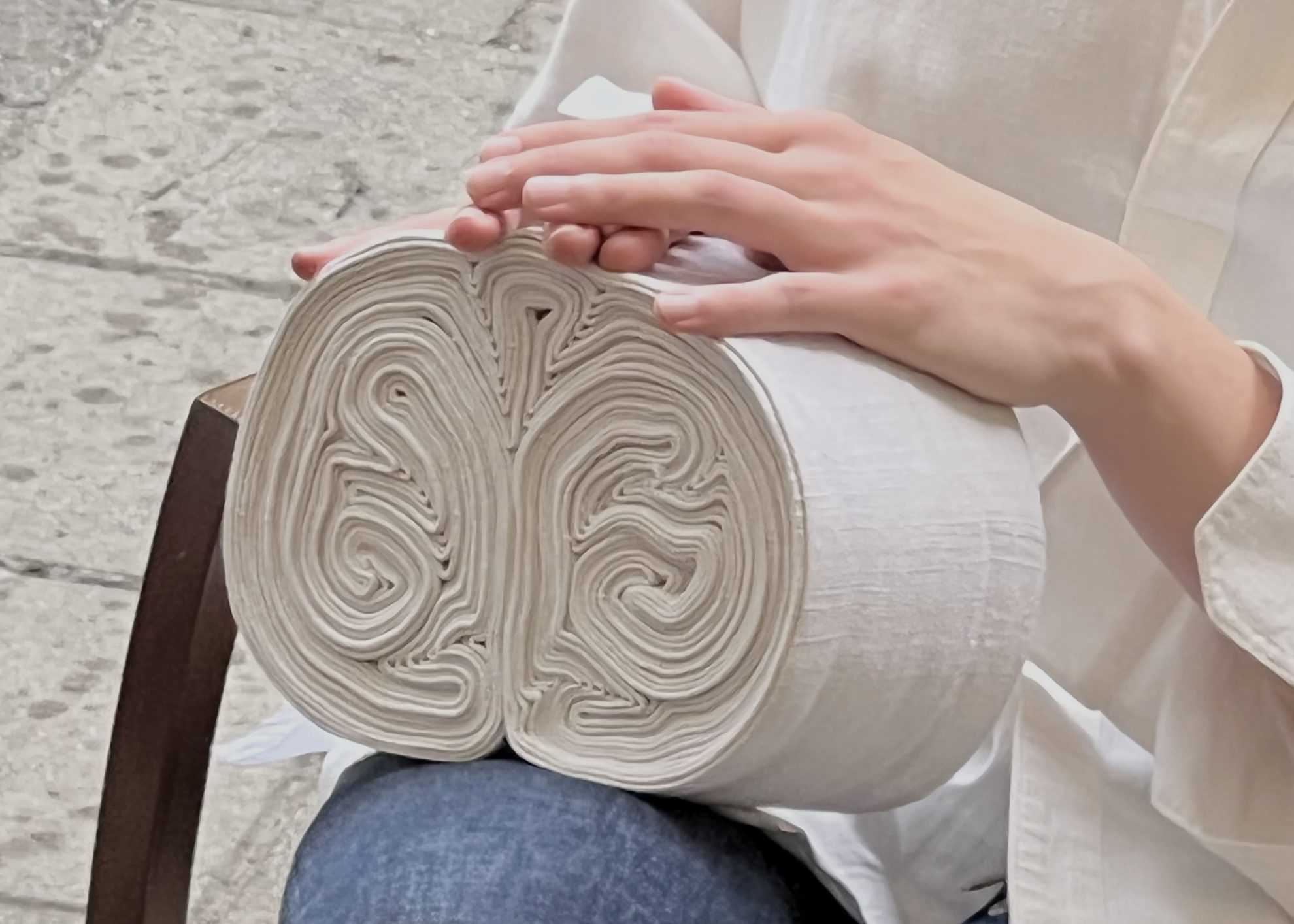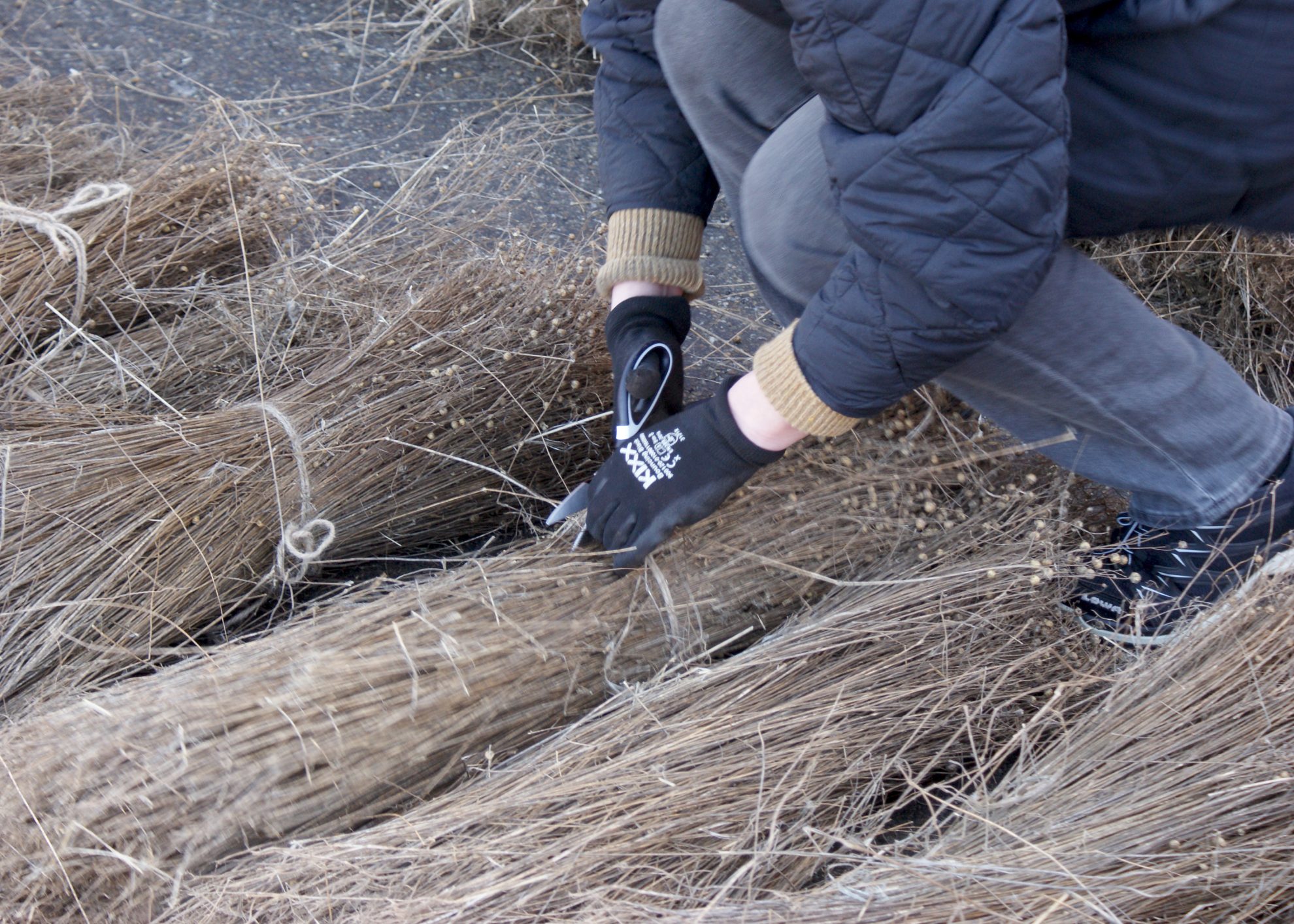Flourishing with flax
How an ancient crop can help us re-root
Text: Iris te Wieske
Several new collections every year and sale at the end of each season. Resisting rapidly changing trends and cheap(er) products can be quite difficult. Believe me, I know. When I bought my first clothes with my allowance, I didn’t really think about how and under which conditions they were made. That changed when I started studying Fashion & Branding, and learned about the textile supply chain. But the biggest change came when, years later, I started my own vegetable garden.
Toward the end of each the year, the seed catalog arrived. We thought about what we wanted to grow next year, made a layout for the garden and prepared the soil. In the spring, we carefully sowed the seeds. The seed trays on the windowsill, waiting for the first rays of sunlight. On our knees we would pull out the weeds, and in dry periods we would cycle to the garden twice a day to water everything. While some crops grew beyond expectations, others failed completely. No, I didn’t always feel like going. But when we could harvest kilos of strawberries, spinach and rhubarb and hand them out to friends, family and neighbors, it was such a rich feeling!
Although it may not always be realistic in this day and age, and we should be grateful for all the technical advances, these experiences can hold a lot of value: maintaining a vegetable garden, making your own garment or piece of furniture, returning to ancient knowledge and working with your hands and the elements. It creates a connection with yourself and your environment. An opinion I share with Willemien Ippel, co-founder of Crafts Council Netherlands and The Linen Project.
Willemien: ”We are no longer used to depending on the weather for our clothes. The same goes for our food. This uproots us, and that’s a big motivation for me.”
The Linen Project
The Linen Project started in 2018 with a study into the economic viability of small-scale, local flax cultivation and linen production in the Netherlands. This resulted in the first Dutch organic flax harvest since the 1950s. The project also involves social, ecological and cultural aspects. Within The Linen Project, the Linen Stewards form the community. It is a group of 30 people who have collectively committed themselves to the cultivation of flax. Together they bear responsibility and care for the entire process from seed to end product.
Willemien: ‘’The Linen Stewards are also referred to as linen evangelists. We preach awareness around the whole process. Everyone who has participated, thinks about textiles and clothing in a different way afterwards.”
In addition to practical experience, knowledge also creates more connection. A great reason to learn more about flax.
A golden history
Flax is an ancient crop that provides the raw material for linen. Flax cultivation has a long and rich history and once experienced golden years in the Netherlands. Cultivation and applications were not only economically important at the time. Throughout history there are countless known and less known stories that also reveal the cultural and spiritual significance of linen.
For the oldest known story about flax, we have to go back in time some 30,000 years, to a cave in Georgia. Here archaeologists found the first dyed flax fibers. But much better known is the use of linen by the Egyptians. In the Nile Valley, plenty of flax was grown to make fabrics and garments. From the fineness of the fabric, the social class of the wearer could be deduced. The fabric also played an important role in religious practices. For example, the Egyptians used linen for mummification. Here the fabric became a sacred symbol, associated with purity and rebirth. Similar elements can be found in Christianity, where the Bible describes Jesus’ body being wrapped in linen.
Then a little closer to home. In the Netherlands, flax has been grown since the Middle Ages. Flanders was the center of flax cultivation at that time, but flax was also grown in abundance in Zeeland. You can still walk across the Vlasmarkt in the center of Middelburg, and you will find several traditional flax barns here.
Linen was often grown in communities. Especially in poorer communities, linen was of great (economic) importance. For example, for the (bridal) trousseau, which was sometimes started as early as age 12. Flax was not an easy crop. Cultivation required a great deal of attention and skill, which meant that flax growers used to be held in high esteem. Also, both growing and processing were very labor intensive. And that’s not much different today.
Willemien: ”Flax is also called ‘het juffertje’ of agriculture, because it is such a vulnerable crop. We have experienced several times that wind and rain have thrown a spanner in the works. A heavy downpour can cause an entire field full of flax stems to slam to the ground.”
Despite this labor-intensive process, linen was for a long time more affordable than cotton. It was used for clothing, but also for a variety of other household textiles such as bedding and tablecloths. The finest linen was given a place in the linen closet, once the showpiece of the house.
The rise of cotton
Although the cultivation of flax once flourished in the Netherlands, during the 19th century it increasingly disappeared into the background due to the large-scale import of cotton. The processing of flax largely shifted to Asia, the golden yellow fields slowly disappeared from the landscape, and with this, the in-depth knowledge of the crop also decreased. Nevertheless, linen originating from flax from northwestern Europe is still considered the best in the world and the Netherlands, Belgium and France are today the largest producer. However, the processing of this European flax often takes place far out of our sight, in low-wage countries.
Most of our clothing today is made from cotton and polyester. Whereas linen thrives in our climate and soil, the cotton plant only grows outside Europe. But the growing demand for sustainable and locally grown raw materials, is making flax and its related crafts relevant again.
Willemien: ”We are no longer used to having so many crafts around a crop. From the seed, to the farmer, those who harvest, the spinners and weavers.” It made the fabric valuable, so people used it sparingly.
From seed to flax fiber in 100 days
The flax plant (Linum usitatissimum) is an annual plant that grows from seed to fine, green flax stalk in 100 days. It can grow about 70 to 90 cm tall. Flax grows from linseed which must be sown in the spring. According to an old peasant wisdom, preferably on the hundredth day of the year (around April 10).
By the end of May, the flax field turns into a beautiful sea of green stalks with tiny blue flowers. If you want to enjoy this magical sight, you have to be quick: each flower blooms for only a single morning before turning into a seed capsule. In July, when the tiny seed capsules have been formed, the stalks turn from green to golden yellow and the leaves begin to fall from the stalks, the flax can be harvested. In order to achieve maximum fiber length, the flax stalks are pulled out of the ground by hand in small bunches. Because the fiber extends to the tip of the root, the plant is harvested with root and all. A tough job that requires frequent breaks. Then, the stalks have only been harvested. Wondering what happens after the harvest?
> We made a video series about the whole process from flax to linen
The most useful species
The Latin name of the flax plant, Linum usitatissimum, means most useful linen. A fitting name because flax is a versatile crop that can be used in its entirety. It’s best-known use is of course linen, which is made from the plant’s fibers. But the same fibers can also be made into rope or paper. The plant’s seeds are used to make linseed oil or extracted for sowing. Flax is also increasingly used for various applications in construction. For example, the shorter fibers are processed into insulation material.
Flax also has many ecological advantages. Unlike cotton, it requires little water and pesticides to grow. This contributes to increased biodiversity. In addition, the plant stores CO2 and its deep roots provide loose and healthy soil.
Let’s re-root ourselves
Maybe you sleep under a linen bed cover, or your favorite blouse is made of linen. Now that you know more about this ancient crop, I hope you will look at these items in a different way. How wonderful it would be if, through a combination of knowledge and practice, we re-root ourselves. That we reconnect with the ground beneath our feet and the origin of the products we surround ourselves with every day. That we cherish them because of the extraordinary stories they hold. And then, maybe, the linen cabinet will once again become a symbol for the way we care.

